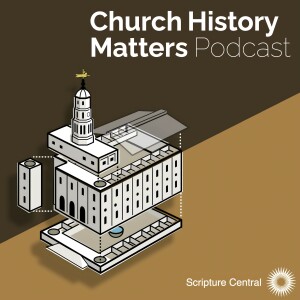Episodes

28 minutes ago
28 minutes ago
How does modern science influence the way we read and understand scripture—without diminishing faith? In this episode, hosts Scott Woodward and Casey Griffiths explore how scientific discovery can deepen, rather than threaten, a religious worldview. They discuss how scripture is primarily concerned with teaching eternal truths about God, humanity, and purpose—the “why” of existence—while science excels at uncovering the “how” of the natural world.
When each is allowed to operate within its proper sphere, science can clarify historical context, illuminate metaphor and symbolism, and help believers read sacred texts with greater humility and insight. Rather than framing science and religion as competitors, Scott and Casey show how faith has often grown stronger when believers engage honestly with scientific knowledge. From creation accounts to miracles, they explain why not every scriptural passage is meant to be read as a scientific textbook—and how that realization can actually protect faith during moments of doubt. This conversation offers a thoughtful, faith-forward approach to scripture study, encouraging viewers to embrace both revelation and reason as complementary gifts from God that work together to point us toward truth.

7 days ago
7 days ago
The holy scriptures are sacred records written by real people—prophets shaped by their culture, language, and historical moment—yet inspired by the Holy Spirit. In this video, we explore how God works through imperfect humans to communicate eternal truths, and why the scriptures were never meant to function as scientific textbooks or literal play-by-play histories in every detail. Instead, the scriptures are primarily concerned with why we exist: our relationship with God, our divine identity as His children, and the purpose of life. They use poetry, symbolism, metaphor, and narrative to teach spiritual truths that transcend time and culture. Taking every verse literally can sometimes cause us to miss the deeper message God intends to convey. Science, by contrast, excels at answering different questions—how the universe works, who was involved, what happened, and when and where events occurred. When properly understood, science and scripture are not enemies but partners, each addressing different aspects of truth. This video invites viewers to adopt a faithful and thoughtful approach to scripture—one that honors inspiration, welcomes scholarship, and allows both revelation and reason to work together in the search for truth.

Tuesday Dec 30, 2025
Tuesday Dec 30, 2025
In this kickoff episode of a new Church History Matters series, hosts Casey Griffiths and Scott Woodward explore one of the most important conversations of our time: the relationship between science and religion—through the lens of Latter-day Saint theology. Drawing on history, philosophy, and faith, Casey and Scott examine two contrasting scientific worldviews represented by figures such as Richard Dawkins, who argues for a strictly material universe, and Albert Einstein, who saw room for awe, mystery, and meaning beyond equations.
How do these perspectives shape the way we understand God, creation, and humanity’s place in the cosmos? This episode also tackles a crucial distinction: Science excels at answering the questions of who, what, when, where, and how—but it remains silent on the ultimate question of why.
Latter-day Saint doctrine offers a framework where scientific discovery and divine purpose are not enemies, but partners in the search for truth. Whether you love science, cherish faith, or feel caught between the two, this series invites thoughtful dialogue, historical context, and a deeper appreciation for how restored theology engages one of the biggest debates in modern thought.

Tuesday Dec 16, 2025
Tuesday Dec 16, 2025
Welcome to Church History Matters Come Follow Me Edition where we are systematically diving into every section of the Doctrine and Covenants throughout the year 2025! In this episode Scott and Casey cover their plans for 2026 with many new exciting topics to come!

Tuesday Dec 09, 2025
Tuesday Dec 09, 2025
Welcome to Church History Matters Come Follow Me Edition where we are systematically diving into every section of the Doctrine and Covenants throughout the year 2025! In this episode Scott and Casey cover the Family Proclamation, while covering the context, content, controversies and consequences of this important history.

Thursday Dec 04, 2025
Thursday Dec 04, 2025
Welcome to Church History Matters Come Follow Me Edition where we are systematically diving into every section of the Doctrine and Covenants throughout the year 2025! In this episode Scott and Casey cover the Articles of Faith, while covering the context, content, controversies and consequences of this important history.

Wednesday Dec 03, 2025
Wednesday Dec 03, 2025
Welcome to Church History Matters Come Follow Me Edition where we are systematically diving into every section of the Doctrine and Covenants throughout the year 2025! In this episode Scott and Casey cover Official Declaration 2, while covering the context, content, controversies and consequences of this important history.

Tuesday Dec 02, 2025
Tuesday Dec 02, 2025
Welcome to Church History Matters Come Follow Me Edition where we are systematically diving into every section of the Doctrine and Covenants throughout the year 2025! In this episode Scott and Casey cover Official Declaration 1, while covering the context, content, controversies and consequences of this important history.

Wednesday Nov 26, 2025
Wednesday Nov 26, 2025
Welcome to Church History Matters Come Follow Me Edition where we are systematically diving into every section of the Doctrine and Covenants throughout the year 2025! In this episode Scott and Casey cover Doctrine & Covenants 138, while covering the context, content, controversies and consequences of this important history.

Tuesday Nov 25, 2025
Tuesday Nov 25, 2025
Welcome to Church History Matters Come Follow Me Edition where we are systematically diving into every section of the Doctrine and Covenants throughout the year 2025! In this episode Scott and Casey cover Doctrine & Covenants 137, while covering the context, content, controversies and consequences of this important history.









